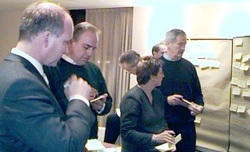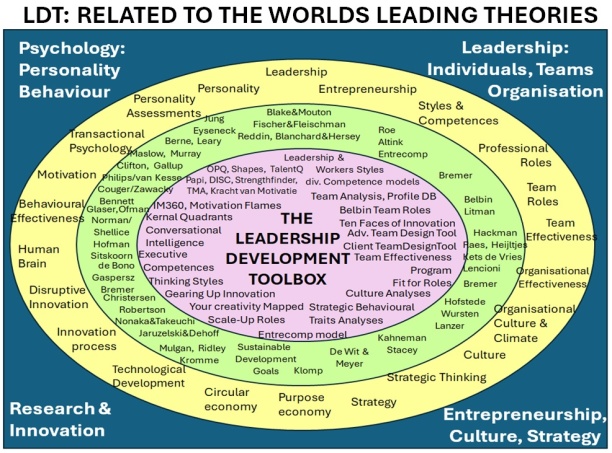PRINCIPLES FOR THE DESIGN
Need for abstraction
To analyse and express ambitions about one's development as leader or professional, a 'language’ is needed. The ‘words’ of this language will enable a person:
- to reflect more deeply upon (the effectiveness of) of his behaviour,
- to think more precise about the strengths and weaknesses of his personality and the type of roles he might play,
- to concretise his development plans,
- and to communicate about it with people around him.
A ‘language’ can be based on descriptions in words but often we use some general concepts and models that structure and differentiate our thoughts and that make us understand and understood. Concepts and models represent the things we try to comprehend, analyse and communicate about.
To comprehend a subject with the help of models is good, but there is also a disadvantage. Concepts and models (paradigms*) are strong simplifications of ‘reality’ from a certain perspective.
There are pro’s and con’s with every type of simplification. We should be aware of the fact that by keeping strict to a model, we can overlook and even might miss the things that have got no place in the model, but that in some situations could be rather important.
*) In science philosophy, a paradigm refers to a complex of models and theories that, inside a given scientific discipline, forms the frame of mind from which reality is described and analysed. Longer existing paradigms tend to become unaware and education makes a paradigm ‘the natural perceived truth’. During a certain period of time, it will be possible to adjust the underlying models and theories. But more often, in time, the belief in the paradigm becomes so strong that anomalies tend to be overlooked and new theories even denied. Until the evidence that the paradigm is invalid becomes so overwhelming that it causes a revolution in people’s perceptions (paradigm shift). Think of the Copernican revolution (the fall of Heliocentrism) and think of, quite actual, disruptive innovation.
Criteria for the development of the LDT
For the design of the toolbox LDpe found it relevant:
- that a formal measurement of a participant’s personality should be used;
- such a measurement method must be worldwide recognized as a ‘good’ method;
- that the measured results should make the starting point for a person’s reflections;
- that the LDT-vocabulary relates to well known leadership and professional concepts;
- that the constructs defined, in a straight way, relate to both the concepts chosen and the scores of the formal measurements.
The vocabulary of the LDT, the ‘words of the language’ are created, structured and defined along with the most common and accepted models and concepts in the domain of leadership and psychology.**) The LDT vocabulary helps a participant to both have an overview of what type of leader/leading professional he wishes to be/become and how to get there by conscious development steps.
The LDT reports help him to breakdown the overall concept of leadership into sub concepts and items that can be addressed as subjects for development.
The LDT encourages the participant’s development and gives insights into possibilities and consequences of behavioural change. This has been achieved by the way the content was structured, starting outside–in (from the domain of leadership towards behavioural preferences) and by creating concepts of leadership styles and professional roles to which the leader is able to link the proper information and interrelations.
The concepts of the toolbox have been tested and applied extensively by hundreds of participants.
**) We have, as much as possible, related the LDT to the leading theories. See below:






